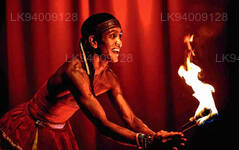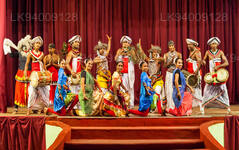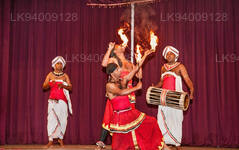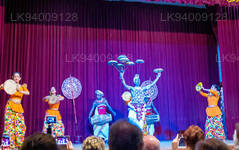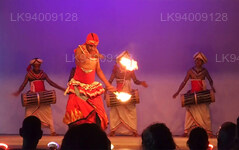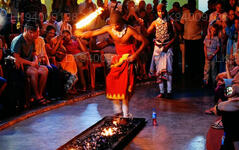
Miasto Kandy
Kandy, malownicze miasto w środkowej Sri Lance, słynie z bogatego dziedzictwa kulturowego, tętniących życiem festiwali i malowniczych widoków. Położone pośród bujnych wzgórz, jest domem Świątyni Zęba, wpisanej na Listę Światowego Dziedzictwa UNESCO, i oferuje urzekające połączenie historii i naturalnego piękna.
Kandy Cultural Show
The Kandy Lake Club Cultural Dance Show is a stimulating Sri Lankan Arts, Dance & Cultural Heritage Show that is a must see for any visitor who visits the historic city of Kandy. The Kandy Lake Club Dance started in 1982 with the view of having a cultural dance performance bringing together all Sri Lankan dance types to one platform. It is the first Cultural Dance Show of its kind to be established in Sri Lanka. It has since become a tourist attraction for many people visiting the country and keen on a glimpse of its rich cultural heritage. Hence it has been performing continuously for the last 35 years. Dance techniques unique to areas of the island are usually passed on from generation to generation. These Dances are performed at local ceremonies and rituals using drums and costumes that are unique to each area. Among the attractions are the Dances depicting the majestic walk of the elephant, colourful performance of the peacock and the mystical movements of the cobra. There are also dances with traditional masks, traditional drums and flames. The show ends with the unbelievable feat of walking on red-hot charcoal, which is a traditional form of worship of local gods. Right throughout the show you can enjoy the sounds of drums and other traditional musical instruments of Sri Lanka.  A hand out in different languages gives our customers a description of every item with all interesting facts and features of the dance show.
The Kandy Lake Club Cultural Dance Show is a stimulating Sri Lankan Arts, Dance & Cultural Heritage Show that is a must see for any visitor who visits the historic city of Kandy. The Kandy Lake Club Dance started in 1982 with the view of having a cultural dance performance bringing together all Sri Lankan dance types to one platform. It is the first Cultural Dance Show of its kind to be established in Sri Lanka. It has since become a tourist attraction for many people visiting the country and keen on a glimpse of its rich cultural heritage. Hence it has been performing continuously for the last 35 years.
- Magul Bera: The blowing of the Conch Shell is the traditional invocation at the commencement of any function and the drums are an integral part of the ritual. It is an ancient Sinhala custom to present ritual music when seeking the blessings of the Guardian of the land.
- Puja Natuma: The female dancers carrying oil lamps are making an offering of their dancing skills to the Guardian Deities.
- Devol Natuma: A dance sequence performed for general immunity from evil influences as well as for healing specific ailments. It is a part of a ceremony connected with folk believes. The vigorous movements of the dancers are derived from the dance forms of the Southern parts of Sri Lanka.
- Mayura Natuma:The female dancers depict the graceful movements of the peacock which according to mythology is the bird that transports Skanda, the War-God of Ceylon, worshipped by Buddhists and Hindus alike.
- Pantheru Natuma: The name of the dance is derived from the musical instrument used, the pantheru, which is close akin to the tambourine. Rhythm is also provided by the accompanying drums. The dance itself shows Sinhala warriors on their way to battle.
- Raksha Natuma: A South Sri Lanka mask dance with the raksha masks symbolising the fight between a cobra and a bird. This dance is used to exorcise demons from the possessed and is still believed to be effective psychiatric treatment in Sri Lanka.
- Lee Keli Natuma: A dance popular in the all parts of the country, particularly during festivals in which both male and female dancers participate. Each dancer has two sticks and the sound of the sticks striking each other together with those of the accompanying drums provide the rhythm for the dancers.
- Raban Natuma: A traditional folk dance which uses the Rabana, an instrument similar to the drum. The popular Ath Rabana (hand Rabana) is almost one foot in diameter and is both played and wielded in a variety of forms by the male and female dancers. Raban playing is accompanied by singing too.
- Gini Sisila: A south Ceylon fire dance showing the power of charms over fire and the twenty seven devils that can trouble mankind. The absolute faith of the fire dancers protects them from the flames. This dance also includes fire-eating.
- Ves Natuma: This dance is the one of the most important forms of Kandyan dance. Ves is the traditional attire of the Kandyan dancer. Sixty four ornaments complete the dress and traditionally their sheen symbolizes the rays of the sun. It takes years of rigorous training before a dancer can achieve the status of a fully-fledged ves dancer.
- Kulu Natuma: A traditional folk dance performed by village damsels to celebrate a rich harvest. The dance portrays sequences from reaping to winnowing of the grain. This is a buoyant dance providing ample opportunities for displaying feminine grace. It is performed to the accompaniment of light drum beats and the haunting strains of the flute.
- Fire walking: The origin of fire walking can be traced back to the epic story of Rama and Sita. Ravana, the King of Ceylon, had abducted the princess of India, Sita. When Rama her husband (an Indian King) regained her, she proved her chastity during her enforced stay with Ravana, by walking on fire, barefoot and unhurt. The devotees who perform fire-walking seek the divine blessings of Lord Kataragama and Goddess Pattini before they do so.
During the show, you will see several dances which depict the graceful movements of birds and animals, which trace their origins back to the ancient ritual known as the Kohomba Kapkariya, as well as energetic acrobatic performances where the men perform a series of leaping pirouettes and stunts such as plate-spinning and the dramatic ‘fire walk’ which ends the show.
O dystrykcie Kandy
Dystrykt Kandy znajduje się w centralnej prowincji Sri Lanki. Kandy, jedno z siedmiu miejsc światowego dziedzictwa na Sri Lance, było kiedyś domem królów Kandy w XVI wieku i źródłem całej muzyki, sztuki, rzemiosła i kultury w kraju. Około 129 km od Kolombo, Kandy jest położone wśród pagórkowatego terenu, a wszystkie oczy zwrócone są ku centrum miasta, gdzie jezioro Kandy stanowi urokliwy element. Kandy zachowuje wielkie znaczenie religijne dla Sri Lanki, ponieważ to w tym uroczym mieście znajduje się Dalada Maligawa lub „Świątynia Zęba”, w której święta relikwia zęba Buddy leży dobrze strzeżona. Królewski Ogród Botaniczny Peradeniya znajduje się około 5 km na zachód od centrum miasta Peradeniya i odwiedza go 1,2 miliona ludzi rocznie. Jest to największy ogród botaniczny na wyspie. Udawatta Kele (Las Udawatta) to chronione sanktuarium położone w sercu miasta, na północ od Świątyni Zęba. Kandy to miasto, w którym większość stanowią Syngalezi; zamieszkują je liczne społeczności należące do innych grup etnicznych, takich jak Maurowie i Tamilowie. Kandy ustępuje jedynie Kolombo centrum gospodarki Sri Lanki. Wiele dużych przedsiębiorstw ma w Kandy rozbudowane filie, a wiele gałęzi przemysłu, takich jak tekstylia, meble, technologie informatyczne i jubilerstwo, znajduje się tutaj. W mieście znajduje się wiele ośrodków badawczych w rolnictwie, a także źródło muzyki, sztuki, rzemiosła i kultury kraju. Kandy, położone około 129 km od Kolombo, położone jest na pagórkowatym terenie, a wszystkie oczy zwrócone są w stronę centrum miasta, gdzie jezioro Kandy stanowi urokliwy punkt orientacyjny. Kandy zachowuje ogromne znaczenie religijne dla Sri Lanki, ponieważ to właśnie w tym urokliwym mieście znajduje się Dalada Maligawa, czyli Świątynia Zęba, w której strzeżona jest święta relikwia zęba Buddy.
O prowincji centralnej
Prowincja Centralna Sri Lanki składa się głównie z terenów górzystych. Prowincja ma powierzchnię 5674 km² i liczy 2 421 148 mieszkańców. Do większych miast należą Kandy, Gampola (24 730), Nuwara Eliya i Bandarawela. Ludność jest mieszanką Syngalezów, Tamilów i Maurów. Zarówno stolica gór Kandy, jak i miasto Nuwara Eliya znajdują się w Prowincji Centralnej, podobnie jak Sri Pada. Prowincja produkuje dużą część słynnej herbaty cejlońskiej, uprawianej przez Brytyjczyków w latach 60. XIX wieku po tym, jak wyniszczająca choroba zniszczyła wszystkie plantacje kawy w prowincji. Prowincja Centralna przyciąga wielu turystów, a jej górskie miejscowości, takie jak Kandy, Gampola, Hatton i Nuwara Eliya, to popularne górskie kurorty. Świątynia Zęba, zwana Dalada Maligawa, jest głównym miejscem świętym w prowincji Centrel. Klimat jest chłodny, a wiele obszarów położonych na wysokości około 1500 metrów n.p.m. charakteryzuje się chłodnymi nocami. Zachodnie stoki są bardzo wilgotne, w niektórych miejscach spada tam prawie 7000 mm deszczu rocznie. Wschodnie stoki należą do strefy średniosuchej, ponieważ deszcz pada tam wyłącznie z monsunu północno-wschodniego. Temperatury wahają się od 24°C w Kandy do zaledwie 16°C w Nuwara Eliya, położonej 1889 m n.p.m. Najwyższe góry Sri Lanki znajdują się w Prowincji Centralnej. Teren jest w większości górzysty, z głębokimi dolinami. Dwa główne regiony górskie to masyw centralny i pasmo Knuckles na wschód od Kandy.

